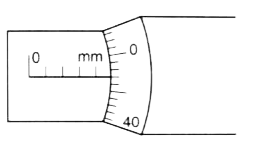The pitch of a screw gauge is 1 mm and there are 100 divisions on the circular head. While measuring the diameter of a wire, the main scale reads 3 mm and the 55th division is in line with the base line. Find the diameter of the wire. Assume that the screw gauge is free from zero error.
To find the diameter of the wire using the screw gauge, we will follow these steps:
Step 1: Identify the given values
- Pitch of the screw gauge = 1 mm
- Number of divisions on the circular head (C) = 100
- Main scale reading (MSR) = 3 mm
- Vernier scale reading (VSR) = 55th division
Step 2: Calculate the least count of the screw gauge
The least count (LC) of the screw gauge can be calculated using the formula:
Least Count=PitchNumber of Circular Scale Divisions
Substituting the values:
Least Count=1 mm100=0.01 mm
Step 3: Calculate the Vernier scale reading
The Vernier scale reading can be calculated by multiplying the Vernier scale division (VSD) by the least count:
Vernier Scale Reading=VSD×Least Count
Here, VSD = 55, so:
Vernier Scale Reading=55×0.01 mm=0.55 mm
Step 4: Calculate the diameter of the wire
The diameter of the wire can be found by adding the main scale reading and the Vernier scale reading:
Diameter=Main Scale Reading+Vernier Scale Reading
Substituting the values:
Diameter=3 mm+0.55 mm=3.55 mm
Final Answer
The diameter of the wire is 3.55 mm.
---
- Pitch of the screw gauge = 1 mm
- Number of divisions on the circular head (C) = 100
- Main scale reading (MSR) = 3 mm
- Vernier scale reading (VSR) = 55th division
The least count (LC) of the screw gauge can be calculated using the formula:
Least Count=PitchNumber of Circular Scale Divisions
Substituting the values:
Least Count=1 mm100=0.01 mm
The Vernier scale reading can be calculated by multiplying the Vernier scale division (VSD) by the least count:
Vernier Scale Reading=VSD×Least Count
Here, VSD = 55, so:
Vernier Scale Reading=55×0.01 mm=0.55 mm
The diameter of the wire can be found by adding the main scale reading and the Vernier scale reading:
Diameter=Main Scale Reading+Vernier Scale Reading
Substituting the values:
Diameter=3 mm+0.55 mm=3.55 mm
The diameter of the wire is 3.55 mm.
Topper's Solved these Questions
- MEASUREMENTS AND EXPERIMENTATION Book:ICSEChapter:MEASUREMENTS AND EXPERIMENTATION Exercise:EXERCISE 1(A)
Explore 51 Videos
- MEASUREMENTS AND EXPERIMENTATION Book:ICSEChapter:MEASUREMENTS AND EXPERIMENTATION Exercise:EXERCISE 1(A) (Multiple Choice type)
Explore 5 Videos
- MAGNETISM Book:ICSEChapter:MAGNETISM Exercise:EXERCISE-10(B) (Multiple Choice Type)
Explore 2 Videos
- MOTION IN ONE DIMENSION Book:ICSEChapter:MOTION IN ONE DIMENSION Exercise:EXERCISE -2 (C) ( Multiple choice type :)
Explore 17 Videos
Similar Questions
The pitch of a screw gauge is 1 mm and its circular scale has 100 divisions. In measurement of the diameter of a wire, the main scale reads 2 mm and 45th mark on circular scale coincides with the base line. Find the diameter of the wire.
View SolutionThe pitch of a screw gauge is 1mm and there are 100 divisions on circular scale. While measuring the diameter of a wire, the linear scale reads 1 mm and 47th division on circular scale coincides with reference line. The length of the wire is 5.6 cm. Find the curved surface area of the wire in cm2 to correct number of significant figures.
View SolutionThe pitch of a screw gauge is 1 mm and its circular scale has 100 divisions. In measurement of the diameter of a wire, the main scale reads 2 mm and 45th mark on circular scale coincides with the base line. Find the least count .
View SolutionThe pitch of a screw gauge is 1mmandthereare100÷isions on the circular scale. In measuring the diameter of a sphere there are six divisions on the linear scale and forty divisions on circular scale coincide with the reference line. Find the diameter of the sphere.
View SolutionThe pitch of a screw gauge is 1mm and its cap is divided into 100 divisions. When this screw gauge is used to measure the diameter of a wire, then main scale reading is 2mm and 58th division of circular scale coincides with the main scale. There is no zero error in the screw gage. Then the diameter of the wire is
View SolutionA screw gauge with a pitch of 1 mm has 100 divisions on its circular scale. What it is used to measure the diameter of a thin wire, the main scale reading is 3 mm and the circular scale reading is 45. If D is the diameter of the wire in mm, then find the value of D.
View SolutionFig. below shows the reading obtained while measuring the diameter of a wire with a screw gauge. The screw advances by 1 division on main scale when circular head is rotated once.

Find the diameter of the wire.
View SolutionA screw gauge has least count of 0.01 mm and there are 50 divisions in its circular scale:
The pitch of the screw gauge is:
View SolutionThe pitch of a screw gauge is 0.5mm and there are 50 divisions on the circular scale. In measuring the thickness of a metal plate, there are five divisions on the pitch scale (or main scale) and thirty fourth divisions coincide with the reference line. Calculate the thickness of the metal plate.
View SolutionThe pitch of a screw gauge is 0.5 mm and the head scale is divided in 100 parts. What is the least count of screw gauge ?
View Solution

